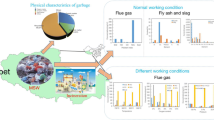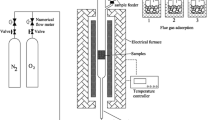Abstract
Aged municipal solid wastes (MSW) excavated from landfills and dumpsites were characterized to analyze their fraction composition, moisture content, and lower heat value (LHV). The necessity and feasibility of recycling combustibles from aged MSW to improve the incineration of fresh MSW were investigated. The results showed that combustibles in aged MSW were easily separated from other components and than LHV of the separated combustibles are higher than 11000 kJ/kg. The fresh MSW are of high moisture contents with average LHV below 6500 kJ/kg, making their stable combustion difficult to maintain in MSW incinerators. For both fresh MSW and aged MSW, plastics are the main contributor to their LHV. To improve incineration of fresh MSW that are characterized with low LHV, combustibles separated from aged MSW were made into refuse derived fuel (RDF) pellets and were then added to fresh MSW by 2% wt.–5% wt. LHV variation and air supply resistance change of the MSW layer on the incinerator grate caused by the addition of RDF was checked, and no significant changes were found. No obvious difference was observed for the ‘burn-out time’ between RDF pellets and fresh MSW either. RDF made from aged MSW combustibles is found to be a promising auxiliary fuel to improve the incineration of fresh MSW, and aged MSW from old landfill cells and dumpsites can be finally disposed of jointly with fresh MSW by recycling combustible from the former to be coincinerated with the latter in the incineration plants.
Similar content being viewed by others
References
National Bureau of Statistics of China. China Statistical Yearbook-2005. Beijing: China Statistics Press, 2005, Electronic version: Chapter 11, Section 3 (in Chinese)
Ministry of Construction of the People’s Republic of China. City & Town Environment and Sanitation Plan for the Eleventh Five Year. Beijing: 2006 (in Chinese)
Bilitewski H, Conrad H, Grischek H. Transposition and reconstruction of old landfill sites in East Germany. In: Proceedings SARDINIA 1995, 5th International Landfill Symposium, Caglari. 1995, 807–818
Brammer F, Kucklick M, Collins H J, Hanert H H. Landfill mining: A possibility to reduce landfill volume and environmental pollution. In: Proceedings of SARDINIA 1995, 5th International Landfill Symposium, Caglari. 1995, 795–806
Obermeier T, Hensel J, Saure T. Landfill mining: Energy recovery from combustible fractions. In: Proceedings of SARDINIA 1997, 6th International Landfill Symposium, Cagliari. 1997, 569–578
Hogland W, Marques M and Nimmermark S. Landfill mining and waste characterization: A strategy for remediation of contaminated areas. J Mater Cycles Waste Manag, 2004, 6: 119–124
Consonni S, Giugliano M, Grosso M. Alternative strategies for energy recovery from municipal solid waste: Part A: Mass and energy balances. Waste Management, 2005, 25(2): 123–135
Consonni S, Giugliano M, Grosso M. Alternative strategies for energy recovery from municipal solid waste: Part B: Emission and cost estimates. Waste Management, 2005, 25(2): 137–148
Chang Y H, Chen W C, Chang N B. Comparative evaluation of RDF and MSW incineration. Journal of Hazardous Materials, 1998, 58(1): 33–45
Wei X, Sheng H, Liu D, Tian W, Qin C, Xiao Y. Formation of CO, SO2 and HCl during RDF incineration in a fluidized. Acta Scientiae Circumstantiae, 2005, 25(1): 34–38 (in Chinese)
Kouvo P, Backman R. Estimation of trace element release and accumulation in the sand bed during bubbling fluidized cocombustion of biomass, peat, and refuse-derived fuels. Fuel, 2003, 82(7): 741–753
Martin P, Norbert von T, Eberhard J, Ernst W. Recycling of plastics in Germany. Resources, Conservation and Recycling, 2000, 29: 65–90
Zhou G, Chen D, Cui W. Comparison between fresh and aged municipal solid wastes and their recycling methods in China. In: Proceedings of SARDINIA 2007, 11th InternationalWaste Management and Landfill Symposium, Cagliari. 2007, 69–70
Al-Salem S M, Lettieri P, Baeyens J. Recycling and recovery routes of plastic solid waste (PSW): A review. Waste Management, 2009, 29(10): 2625–2643
Caputo A C, Pelagagge P M. RDF production plants: I Design and costs. Applied Thermal Engineering, 2002, 22(4): 423–437
Author information
Authors and Affiliations
Corresponding author
Rights and permissions
About this article
Cite this article
Chen, D., Guan, Z., Liu, G. et al. Recycling combustibles from aged municipal solid wastes (MSW) to improve fresh MSW incineration in Shanghai: Investigation of necessity and feasibility. Front. Environ. Sci. Eng. China 4, 235–243 (2010). https://doi.org/10.1007/s11783-010-0016-5
Received:
Accepted:
Published:
Issue Date:
DOI: https://doi.org/10.1007/s11783-010-0016-5




